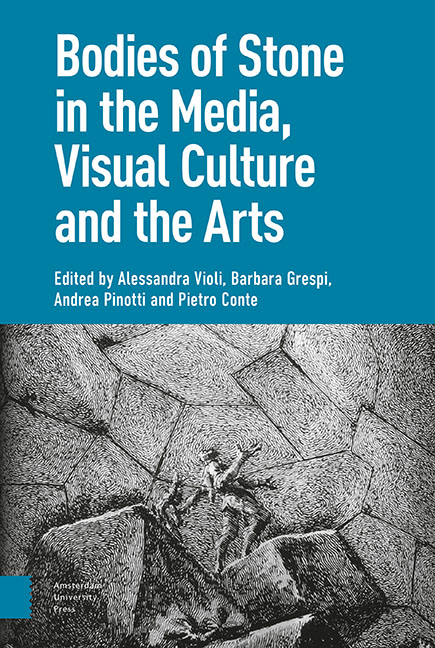Book contents
- Frontmatter
- Contents
- Introduction: Learning from Stone
- I Statue: The Imaginary of Uncertain Petrification
- 1 Theatre and Memory: The Body-as-Statue in Early Modern Culture
- 2 Translated Bodies: A ‘Cartographic’ Approach
- 3 Pantomime in Stone: Performance of the Pose and Animal Camouflage
- 4 Animated Statues and Petrified Bodies: A Journey Inside Fantasy Cinema
- 5 The Ephemeral Cathedral: Bodies of Stone and Configurations of Film
- II Matter: Size, Hardness, Duration
- 1 Bodies That Matter: Miniaturisation and the Origin(s) of ‘Art’
- 2 Brancusi’s ‘Sculpture for the Blind’
- 3 Cinema, Phenomenology and Hyperrealism
- 4 Ephemeral Bodies: The ‘Candles’ of Urs Fischer
- 5 The Celluloid and the Death Mask: Bazin’s and Eisenstein’s Image Anthropology
- III Corpse: Fossils, Auto-Icons, Revenants
- 1 Funeral Eulogy: Post-Mortem Figures and Redeemed Bodies, in Images
- 2 On Jack Torrance As a Fossil Form
- 3 Technical Images and the Transformation of Matter in Eighteenth-Century Tuscany
- 4 Glass, Mixed Media, Stone: The Bodily Stuffs of Suspended Animation
- 5 Bodies’ Strange Stories: Les Revenants and The Leftovers
- IV Monument: Embodying and Grafting
- 1 The Impassibly Fleshly, the Statue of the Impossible
- 2 Frozen into Allegory: Cleopatra’s Cultural Survival
- 3 The Orphan Image
- 4 The Well-Tempered Memorial: Abstraction, Anthropomorphism, Embodiment
- 5 Monuments of the Heart: Living Tombs and Organic Memories in Contemporary Culture
- Index
3 - Cinema, Phenomenology and Hyperrealism
Published online by Cambridge University Press: 20 November 2020
- Frontmatter
- Contents
- Introduction: Learning from Stone
- I Statue: The Imaginary of Uncertain Petrification
- 1 Theatre and Memory: The Body-as-Statue in Early Modern Culture
- 2 Translated Bodies: A ‘Cartographic’ Approach
- 3 Pantomime in Stone: Performance of the Pose and Animal Camouflage
- 4 Animated Statues and Petrified Bodies: A Journey Inside Fantasy Cinema
- 5 The Ephemeral Cathedral: Bodies of Stone and Configurations of Film
- II Matter: Size, Hardness, Duration
- 1 Bodies That Matter: Miniaturisation and the Origin(s) of ‘Art’
- 2 Brancusi’s ‘Sculpture for the Blind’
- 3 Cinema, Phenomenology and Hyperrealism
- 4 Ephemeral Bodies: The ‘Candles’ of Urs Fischer
- 5 The Celluloid and the Death Mask: Bazin’s and Eisenstein’s Image Anthropology
- III Corpse: Fossils, Auto-Icons, Revenants
- 1 Funeral Eulogy: Post-Mortem Figures and Redeemed Bodies, in Images
- 2 On Jack Torrance As a Fossil Form
- 3 Technical Images and the Transformation of Matter in Eighteenth-Century Tuscany
- 4 Glass, Mixed Media, Stone: The Bodily Stuffs of Suspended Animation
- 5 Bodies’ Strange Stories: Les Revenants and The Leftovers
- IV Monument: Embodying and Grafting
- 1 The Impassibly Fleshly, the Statue of the Impossible
- 2 Frozen into Allegory: Cleopatra’s Cultural Survival
- 3 The Orphan Image
- 4 The Well-Tempered Memorial: Abstraction, Anthropomorphism, Embodiment
- 5 Monuments of the Heart: Living Tombs and Organic Memories in Contemporary Culture
- Index
Summary
Abstract
Traditionally, hyperrealistic mannequins have embodied the dream (or rather the nightmare) of animating the inanimate: by imitating the living model to such an extent that any distinction becomes (almost) impossible, they blur the threshold between life and inert matter. It thus comes as no surprise that wax figures have often been taken as a symbol of cinematic creation and its attempt to recreate motion (a quality immediately associated with life) by means of a sequence of static frames. By focusing on three classic movies—Robert Wiene's The Cabinet of Dr. Caligari(1920), Paul Leni's Waxworks(1923) and Michael Curtiz's Mystery of the Wax Museum(1933)—the essay explores the tension between reality and unreality as the crux of cinema tout court.
Keywords: Aesthetics; film studies; mummy complex; animation; hyperrealism; wax figures
In his renowned essay first published in 1937 and then revised in 1947, Style and Medium in the Motion Pictures, Erwin Panofsky reminds readers that the earliest narrative movies were not at all just trivial imitations of the genus proximumof theatre plays; rather, they preferred to add movement to originally stationary works of art, such as the wax figures ‘à laMadame Tussaud’. Without providing any further explanation, the art historian touched upon a crucial topic for cinema studies, that of the animation of the inanimate and the paradoxical attempt to recreate motion(a quality immediately associated with life) by means of a sequence of staticframes, pushing mimetic strategies to the limit by trying at the same time to escape the fate of photographic images, unavoidably condemned to immerse reality in a ‘stop bath (bain de fixation)’ and to ‘cut into the living so as to perpetuate the dead’. Providing mummies with the ability to move: this is the logical conclusion of the ‘obsession with realism’ that André Bazin was mulling in the very same years Panofsky's essay was published.
It should therefore come as no surprise that between cinema and wax statues there was love at first sight, possible only when both sides have something to benefit from the encounter: by animating (even though only in an image) the inanimate, cinema celebrates its own triumph, whereas mannequins, conversely, obtain what they need to finally end the eternal chase after their models, namely, motion.
- Type
- Chapter
- Information
- Bodies of Stone in the Media, Visual Culture and the Arts , pp. 169 - 178Publisher: Amsterdam University PressPrint publication year: 2020



